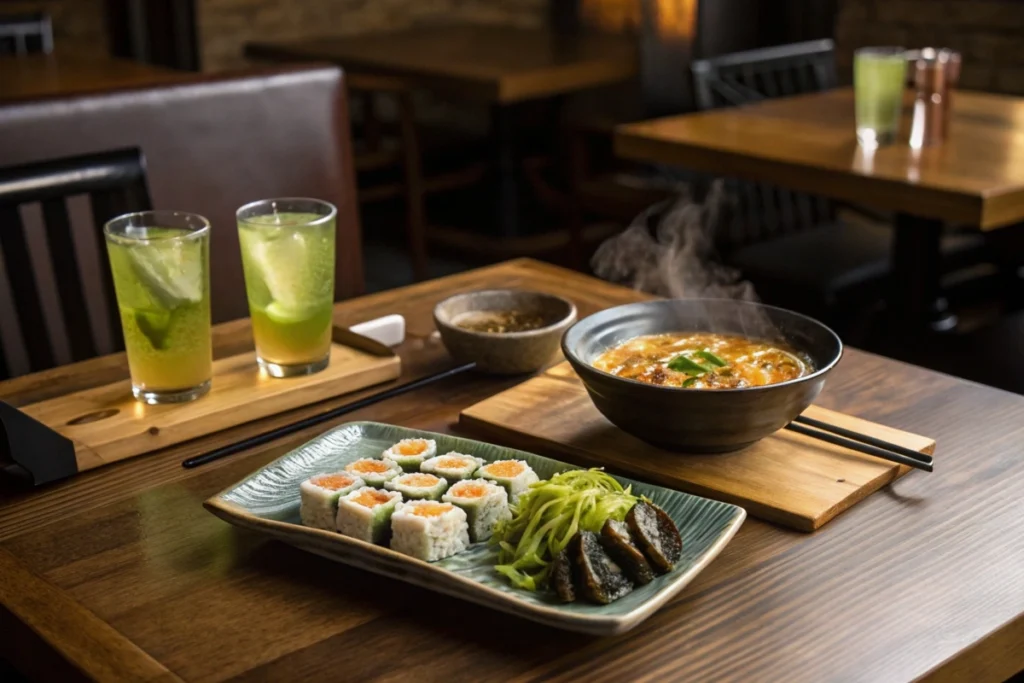Introduction
If you’re searching for japanese food fayetteville nc, get ready to uncover a culinary scene packed with variety. Fayetteville, North Carolina, is home to multiple spots serving everything from classic sushi rolls to flavorful ramen bowls. Whether you’re a fan of fresh sashimi, sizzling hibachi, or comforting miso soup, you’ll find an array of options that cater to diverse tastes. Despite the city’s moderate size, its growing population and cultural influences create a vibrant market for Japanese fare that welcomes both newcomers and longtime enthusiasts alike.
This comprehensive guide aims to spotlight Fayetteville’s Japanese dining landscape—discussing top restaurants, style distinctions, and practical tips for making the most of your local experiences. If you’re a novice to Japanese cuisine, keep in mind that it’s more than just raw fish. You’ll encounter grilled yakitori, hibachi fayetteville nc–style steakhouses, traditional tempura dishes, and so much more. Along the way, we’ll also touch on some cultural insights to give you a deeper appreciation of how these foods made their way to Southeastern North Carolina.
For more background on Japanese cooking techniques and authentic recipes, feel free to discover Japanese recipes that highlight quick meals and modern twists. Now, let’s dive into the flavorful world of Japanese cuisine in Fayetteville.
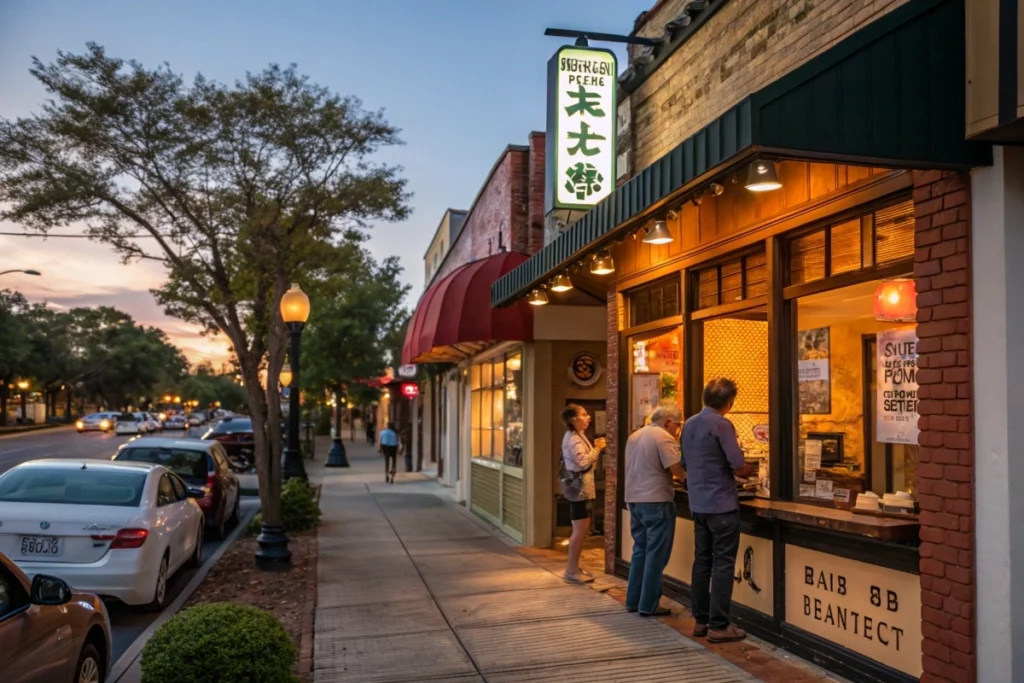
1. Why Japanese Food in Fayetteville, NC?
It might surprise some newcomers that japanese food fayetteville nc is not only available but also diverse and thriving. Historically known for its strong military presence—due to Fort Bragg—Fayetteville has seen an influx of cultural influences as people relocate here from across the U.S. and abroad. That growing diversity fosters demand for global cuisines, including Japanese specialties.
Military Influence and Cultural Exchange
Members of the armed forces often experience overseas deployments, sometimes in Japan, and return with a love for sushi, ramen, and other Japanese favorites. Local entrepreneurs recognized the opportunity, opening restaurants that mirror authentic Japanese cooking methods. Thanks to these experiences, everything from tempura to miso soup finds an appreciative audience. Fayetteville’s evolving food scene is the direct result of the city’s expanding population and culinary curiosity.
Accessibility and Variety
Whether you crave a quick bento box for lunch or a multi-course hibachi dinner show, there’s something for every budget and schedule in Fayetteville. Food courts in shopping plazas might sell quick sushi rolls, while stand-alone eateries often provide a more extensive menu. Some also offer to-go or delivery services for busy individuals seeking convenience. Searching for best ramen in fayetteville nc might lead you to specialized noodle shops that put a modern twist on age-old recipes.
Celebrating Freshness and Quality
Japanese cuisine in Fayetteville often emphasizes fresh produce and high-grade proteins. Even if you’re hesitant about raw fish, chefs can guide you toward cooked sushi options (like shrimp tempura rolls) or grilled main courses. Vegetarians and vegans also discover unique offerings—like hearty tofu bowls or vegetables-japanese-recipe–inspired sides.
Local Community Impact
The success of local Japanese eateries extends beyond satisfying cravings. These establishments create jobs, support local suppliers, and collaborate with farmers to incorporate Southeastern produce. For instance, some spots integrate sweet potatoes or Carolina-grown greens into their modern Japanese fusion dishes, bridging traditions across continents.
Overall, Fayetteville’s Japanese dining scene reflects its melting-pot character. From casual and convenient to gourmet experiences, the city’s restaurants fulfill a range of tastes, letting you either stick to classic favorites or dabble in adventurous new flavors. Ready to focus on specific dish categories and recommended spots? Next, we’ll explore popular sushi joints, innovative hibachi grills, and where to find the best steaming bowls of ramen.
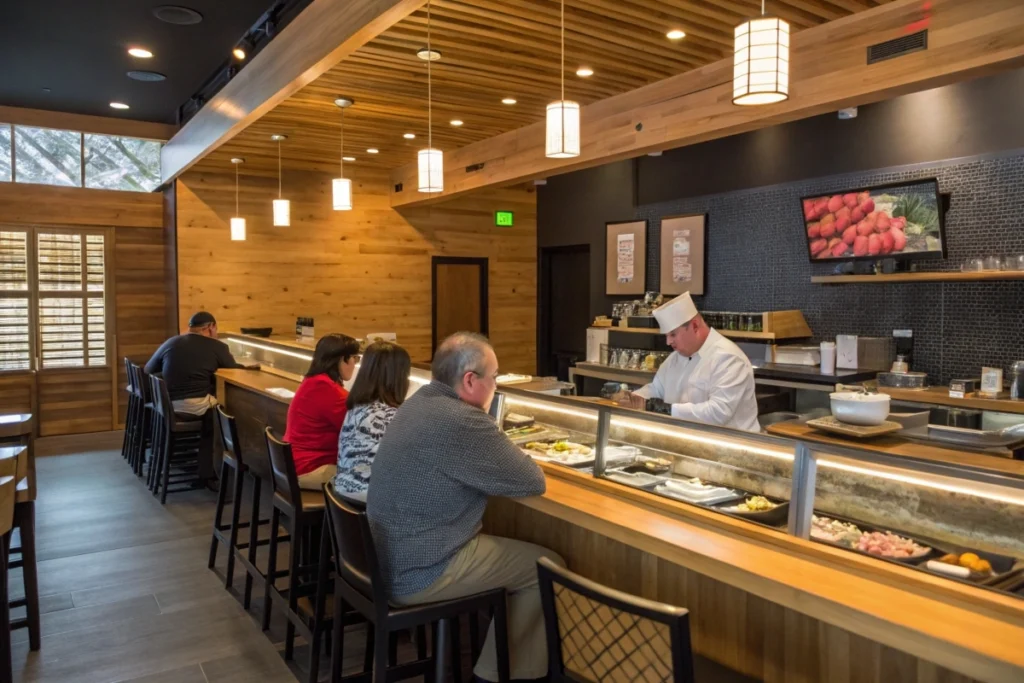
2. Best Sushi Spots and Trends
When it comes to japanese food fayetteville nc, many locals associate it first with sushi. Whether you prefer nigiri, sashimi, or creative rolls, the city’s sushi scene has something for everyone. Let’s highlight what you can expect in terms of both traditional and modern offerings.
Classic Rolls and Freshness
Authentic sushi relies on shari (sushi rice) seasoned with vinegar, sugar, and salt. Topped or filled with fresh fish, vegetables, or eggs, these rolls range from simple maki to more elaborate creations. Fayetteville’s best sushi bars typically emphasize fish quality. Look for menus listing daily specials—like fresh salmon or yellowtail shipped in multiple times a week.
Notable Rolls:
- California Rolls: Popular with those hesitant about raw seafood. Made from imitation crab, cucumber, and avocado.
- Spicy Tuna Rolls: Often includes chili sauce or sriracha mayo, balancing heat with the sweetness of the tuna.
Specialty and Fusion Rolls
Many local restaurants have signature rolls. They might fuse American comfort foods with Japanese elements—think crispy bacon pieces or sweet barbecue sauce drizzles. These “fusion” rolls appeal to adventurous palates. For a deeper dive into preparing your own fish-based specialties at home, check out Japanese fish recipes to see how simple home cooking can be.
Trends in Fayetteville’s Sushi Culture:
- Tempura Crunch: Rolls topped with crunchy tempura flakes or panko for added texture.
- Sauce Variety: Drizzles of unagi sauce (sweet eel sauce), spicy mayo, or ponzu accentuate flavors.
- Vegetarian/Vegan Rolls: Avocado, cucumber, and sweet potato rolls for those skipping meat or fish.
Sashimi and Nigiri for Purists
Beyond rolls, some restaurants serve top-quality sashimi (thinly sliced fish served without rice) and nigiri (fish over pressed rice). Sashimi aficionados appreciate the pristine taste of raw salmon, tuna, or more exotic fish. If you’re unsure about raw fish, many spots offer slightly seared or marinated versions to ease you into the experience.
Creating the Perfect Sushi Night
Some sushi bars also host omakase dinners. In this approach, you let the chef decide your courses, showcasing their skill and the freshest ingredients available. While not as common in every local eatery, a few refined restaurants in Fayetteville may provide this elevated experience. It’s a unique way to sample multiple fish varieties and cooking styles in a single sitting.
From crowd-pleasing California rolls to sashimi platters that showcase the delicacy of raw fish, sushi in Fayetteville is both approachable and ever-evolving. Whether you seek a quick lunch special or an elaborate weekend feast, you’ll find plenty of options to keep your sushi cravings satisfied. Next, let’s shift our attention to other iconic Japanese staples like ramen and hibachi that have equally strong footholds in the city.
3. Ramen, Hibachi, and More
While sushi is popular, japanese food fayetteville nc extends far beyond raw fish. Two other crowd favorites—ramen and hibachi—deserve special mention, particularly for those craving warmth and bold flavors.
Ramen: Comfort in a Bowl
Ramen has gained worldwide fame, transitioning from dorm-room instant noodles to a gourmet obsession. Fayetteville’s ramen shops typically offer a variety of broths:
- Tonkotsu (Pork Bone Broth): Creamy, rich, and loaded with umami. Toppings might include chashu (braised pork), bean sprouts, and a soft-boiled egg.
- Shoyu (Soy Sauce Broth): Lighter but savory, often featuring chicken or fish-based stock.
- Miso Broth: Earthy and slightly sweet, with miso paste at its core. Perfect for those who appreciate a pungent, soybean-forward taste.
Many ramen houses also serve small plates like gyoza (pan-fried dumplings) or karaage (Japanese fried chicken) for a complete meal. For a home-cooking twist on these ideas, see if you can adapt a local noodles-japanese-pan-noodles-recipe to replicate restaurant-like noodles in your kitchen.
Hibachi Grills: Dinner and a Show
Hibachi restaurants give diners a front-row seat to the cooking experience. Chefs juggle utensils, flip shrimp tails into their hats, and create onion “volcanoes” on sizzling griddles—entertaining as they cook. While traditionally Japanese teppanyaki might differ slightly, Americans widely know it as “hibachi.” Fayetteville hosts establishments offering combos of steak, shrimp, chicken, and vegetables, all seasoned with soy sauce and garlic butter. These spots cater especially well to groups and families seeking an interactive meal.
Other Traditional Dishes
- Katsu: Deep-fried cutlets of chicken or pork, typically served with a tangy sauce.
- Donburi: Rice bowls topped with proteins like beef (gyudon) or pork (katsudon).
- Tempura: Lightly battered vegetables or seafood. Crisp outside, tender inside.
Vegetarian and Vegan Options
Don’t assume Japanese cuisine is only for omnivores. A handful of Fayetteville’s restaurants craft tofu ramen, vegetable tempura, or vegan-japanese-recipes–inspired sushi. From sweet potato rolls to marinated mushrooms, there’s often a thoughtful selection for plant-based diners.
Overall, ramen shops offer cozy bowls for chilly nights, while hibachi grills deliver an upbeat vibe perfect for special occasions. In either scenario, expect the synergy of fresh vegetables, quality proteins, and balanced sauces. Next up, let’s explore practical tips for enjoying these flavors, from ordering etiquette to recommended side dishes and condiments.
<a name=”section4″></a>
4. Tips for Enjoying Japanese Cuisine Locally
Whether you’re already a fan of japanese food fayetteville nc or just dipping your toes in, a few practical pointers can heighten your culinary adventure. Below are suggestions on navigating menus, pairing sides, and embracing authentic etiquette.
Navigating Menus
- Check Lunch Specials: Many Japanese restaurants in Fayetteville offer bento boxes or sushi combos at lower prices midday. This helps you sample multiple items.
- Ask About Freshness: If you’re ordering sushi or sashimi, don’t hesitate to inquire about the day’s catches or any specials. Quality fish is crucial.
- Spice Levels: Dishes like spicy tuna roll or spicy miso ramen can vary widely in heat. If you prefer mild, ask your server to reduce the chili or serve sauce on the side.
Pairing Side Dishes & Condiments
- Ginger & Wasabi: For sushi, nibble pickled ginger to cleanse your palate between bites. Use wasabi sparingly to avoid overpowering delicate flavors.
- Miso Soup: Often served as a starter, miso soup preps your palate with a light, savory warmth.
- Tempura or Gyoza: Great add-ons to a main dish. Their crunchy or savory textures complement the softness of sushi or noodles.
Etiquette Tips
- Chopsticks: Avoid sticking them upright in your rice (considered taboo) and never pass food from chopstick to chopstick.
- Slurping (Ramen): In Japan, slurping noodles is polite—it indicates enjoyment. You might practice that tradition or go your own way.
- Soy Sauce Usage: Dip sushi fish-side down, or lightly brush sauce on top. Over-dunking can overshadow the fish’s flavor.
Cultural Immersion
- Tea Ceremonies: Some local restaurants or community centers host tea events, providing an authentic glimpse into Japan’s ceremonial side.
- Seasonal Menus: Japanese chefs love to incorporate seasonal produce. Keep an eye out for dishes featuring local North Carolina vegetables in a Japanese style, bridging cultures.
- Desserts: Round out your meal with mochi ice cream or green tea cake. For an extended dessert repertoire, see japanese dessert recipes that highlight subtle sweetness.
Local Dining Events
Occasionally, you’ll find pop-up events or cultural festivals in Fayetteville celebrating Japanese traditions—like noodle-eating contests or sushi-making workshops. These gatherings are perfect for beginners wanting a fun, interactive introduction to the cuisine.
Armed with these tips, you’re better equipped to explore local menus confidently. Next time you see unfamiliar Japanese dish names, consider them an invitation to broaden your horizons. Our next section dives into the evolving future of Fayetteville’s Japanese dining scene, including fusion and innovative concepts gaining traction.
5. Beyond the Basics: Fusion and Future Trends
Japanese food fayetteville nc isn’t limited to decades-old recipes alone. A new wave of fusion eateries and innovative cooking techniques is reshaping the local restaurant scene. From Japanese-Western crossovers to creative sushi burritos, modern interpretations keep diners engaged while honoring time-tested traditions.
Japanese-Southern Fusion
Some Fayetteville chefs draw on local Southern comfort foods to craft intriguing hybrids. You might spot collard green gyoza or tempura-fried okra served with soy-sweet chili sauce. These items fuse Southeastern produce with Japanese methods, bridging two distinct food cultures for surprising, yet delicious outcomes.
Sushi Burritos and Bowls
In line with a national craze, a few spots now offer sushi burritos—large seaweed-wrapped creations stuffed with fish, veggies, and sauces. Think of it as a handheld sushi roll. Alternatively, poke bowls (inspired by Hawaiian but popular in Japanese cuisine circles) let you customize proteins (salmon, tuna, tofu), veggies, and toppings over rice.
These lighter, grab-and-go items appeal to busy professionals craving fresh flavors. For a heartier approach, you can adapt these concepts at home using resources like a japanese bagel recipe, shaping your own fusion breakfast items.
Technology in Dining
- Self-Ordering Tablets: Some Fayetteville restaurants provide digital menus or iPad-like devices to browse and place orders. This streamlines service and helps non-Japanese speakers identify dishes easily.
- Automated Sushi Conveyors: While not as widespread, conveyor-belt sushi might appear in future expansions, offering a modern, playful dining experience.
Rise of Specialty Shops
While general Japanese eateries remain common, specialized restaurants focusing solely on ramen or yakitori are becoming more prevalent. By honing in on a singular dish type, these shops promise higher quality and authenticity. A ramen fayetteville nc search might reveal spots dedicated to perfecting broth depth and noodle texture.
Embracing Local Produce and Sustainability
In line with global farm-to-table movements, some local chefs incorporate organic and regionally sourced produce into their Japanese-inspired menus. For instance, they might feature sweet potatoes in a seasonal tempura, referencing local North Carolinian staples. This practice not only supports local farmers but also fosters unique flavors and promotes sustainability.
Outlook for Japanese Dining in Fayetteville
As the city expands and gastronomic curiosity continues to grow, expect more restaurants championing new culinary frontiers. Emerging chefs and entrepreneurs might test the waters with multi-course omakase dinners, sake-pairing events, or vegan ramen pop-ups. The best part is that these evolutions still root themselves in the fundamentals of Japanese culture—freshness, balance, and mindful presentation.
From miyabi fayetteville nc–style refined meals to approachable fusion bistros, the local dining scene truly has something for every palate. With each new restaurant opening, Fayetteville’s Japanese cuisine landscape gains depth, ensuring that fans and newcomers alike stay excited about what’s cooking.
History and Context
Although it’s tempting to assume that japanese food fayetteville nc is a recent phenomenon, the background goes further than you might expect. North Carolina’s Southeastern region has experienced waves of cultural exchange, partly due to the military base at Fort Bragg, but also through the broader evolution of American dining trends.
Early Beginnings
Japanese cuisine began appearing in U.S. cities like Los Angeles or New York in the mid-20th century. Yet smaller towns, including Fayetteville, took time to embrace sushi and other specialized dishes. Initially, restaurants might have served pan-Asian menus—blending Chinese, Thai, and Japanese offerings—to appeal to cautious diners.
1980s–1990s: Growth in Asian Food Awareness
As American palates diversified, interest in hibachi steakhouses soared. These establishments, often labeled “Japanese,” introduced many first-timers to soy sauce–based marinades, teppanyaki theatrics, and interactive dining. Fayetteville also saw occasional Japanese-themed events or cooking classes, bridging cultural gaps. Soldiers stationed in Japan returned with stories of authentic sushi bars, spurring local curiosity.
Military Influence
Fort Bragg’s role cannot be understated. International deployments exposed service members to global cuisines, including deep experiences with ramen shops or sushi counters in East Asia. After returning home, they’d seek out comparable flavors. This cyclical pattern—deploy, discover, return—helped anchor Japanese eateries as viable ventures. Over time, even small, family-run sushi bars found loyal supporters among both military personnel and civilians.
Local Pioneers and Entrepreneurship
As Fayetteville’s population increased, entrepreneurial chefs saw room for specialized concepts. Some launched modest sushi counters in grocery stores; others risked opening full-service Japanese restaurants near major shopping centers or popular thoroughfares. Gradually, word-of-mouth recommendations and positive online reviews spurred further expansions.
Modern Scene
By the 2000s, the city boasted multiple sushi, hibachi, and ramen spots, each refining their menus and adding modern twists. The influence of American dining trends—like gluten-free options, vegan-friendly bowls, or “sushi burritos”—ensured these places stayed relevant. Meanwhile, more refined establishments tested multi-course tastings or sake pairings, indicating a matured market unafraid to explore authentic Japanese dishes.
Future Possibilities
Looking ahead, there’s potential for farm-to-table Japanese concepts that spotlight local Southeastern produce. Collaborative pop-ups with neighboring cities or region-wide festivals might also strengthen the spotlight on Japanese cuisine. Given Fayetteville’s dynamic environment—fueled by a mix of local heritage, military presence, and global tastes—Japanese food will likely continue flourishing.
This historical trajectory underscores why Fayetteville stands as a vibrant hub for Japanese fare today. From humble beginnings and shared influences to the contemporary variety we now see, each chapter highlights ongoing dialogue between local culture and the broader culinary world.
Recommended filename: .jpg
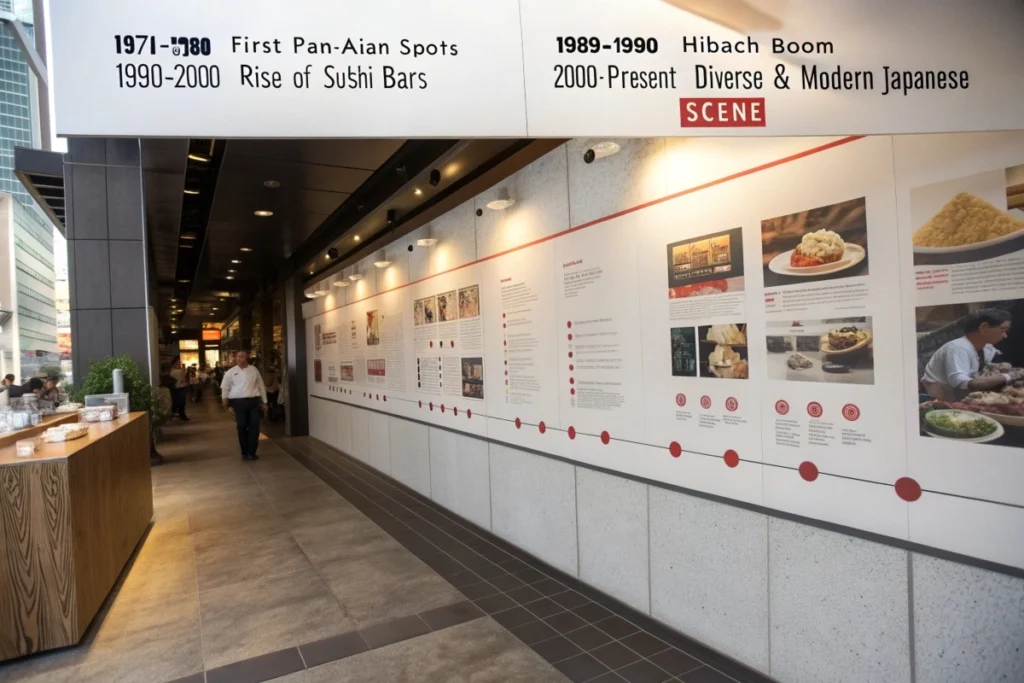
Practical Examples/Use Cases
Scenario 1: A Weekend Food Crawl
Imagine you’re hosting friends who’ve never visited Fayetteville. You arrange a Japanese food crawl across four different spots in one evening. You start with a quick serving of gyoza and miso soup at a small ramen shop downtown. Next, you head to a sushi bar for a California roll and spicy tuna samples. Then, you venture to a hibachi restaurant for sizzling steak and shrimp. Finally, you end the evening at a dessert café offering matcha cheesecake or mochi ice cream. This progressive dinner lets everyone savor the range of options—from casual to more upscale—and showcases just how broad japanese food fayetteville nc can be.
Scenario 2: Home Cooking with Local Ingredients
You decide to recreate a Japanese dinner at home, utilizing produce from Fayetteville’s farmers’ market. You pick up fresh collard greens, sweet potatoes, and local proteins. Incorporating some Japanese chicken fried rice recipe techniques, you season the rice lightly with soy sauce and scramble in farm-fresh eggs. As a side dish, you tempura-fry sweet potato slices, pairing them with a homemade soy-vinegar dip. The fusion approach uses Southeastern produce while adhering to Japanese cooking principles.
Scenario 3: Cultural Lunch and Learn
A local community center hosts a lunch-and-learn session about Japanese culture. A chef from a Fayetteville sushi restaurant demonstrates how to roll nigiri and discusses the significance of fresh fish. Attendees sample small plates like seaweed salad and tamago (egg) sushi. Meanwhile, an instructor shares short slides on Japanese dining etiquette—like not passing food from chopstick to chopstick. This interactive approach fosters not just culinary appreciation but also cultural sensitivity.
- A group of friends navigating different restaurants in an evening food crawl.
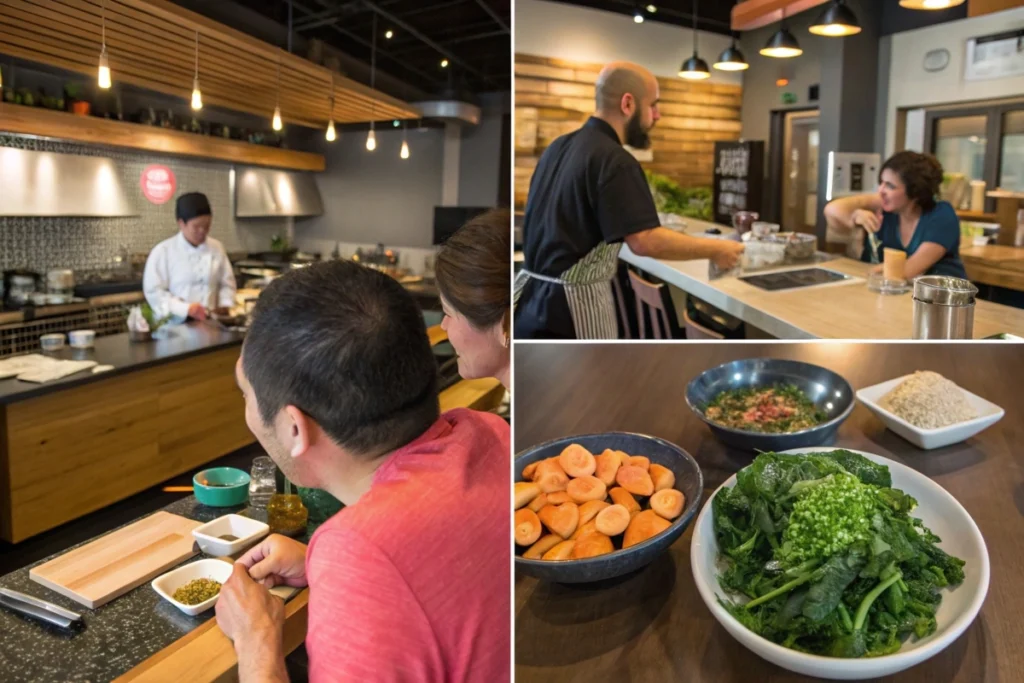
FAQs
Below are common questions people ask regarding japanese food fayetteville nc:
- Which is the best japanese food fayetteville nc spot for beginners?
Look for places offering a wide range of options—like sushi rolls (including cooked varieties) and mild noodles or teriyaki dishes. That way, you can ease into more adventurous options over time. - Are there good vegetarian or vegan Japanese options in Fayetteville?
Yes, many local restaurants cater to plant-based diets, offering veggie sushi rolls, tofu ramen, or vegetables-japanese-recipe–inspired sides. Always confirm ingredient lists since some broths or sauces may include fish stock. - What’s the difference between hibachi fayetteville nc and authentic teppanyaki?
In the U.S., “hibachi” typically refers to the iron griddle cooking style used in restaurants that provide a cooking show. However, in Japan, “teppanyaki” is the precise term. Either way, it’s a fun, interactive way to enjoy steak, seafood, and veggies. - Is ramen fayetteville nc served everywhere or just specialized restaurants?
Fayetteville has specialized ramen shops, but some sushi or pan-Asian spots also include ramen on their menus. Dedicated ramen restaurants often offer deeper flavors and varied broth styles—like tonkotsu, shoyu, or miso. - Can I find miyabi fayetteville nc–style refined dining here?
A few upscale establishments reflect a “miyabi” emphasis on subtlety and elegance. They might serve multi-course meals with carefully arranged sashimi or seasonal ingredients. While not as widespread as big-city kaiseki spots, the local scene continues to evolve. - How do local sushi bars ensure fish quality in a landlocked area?
Many import fish from established suppliers, delivering fresh catches multiple times a week. Reputable spots are transparent about sourcing, so you can always inquire how they maintain freshness. - Which dish should I try if I dislike raw fish?
Cooked items like shrimp tempura rolls, chicken katsu, or veggie ramen suit first-timers. Over time, you can branch out toward nigiri or sashimi once you feel more comfortable.
Conclusion
Japanese food fayetteville nc proves that you don’t need to be in Tokyo or even a major U.S. metropolis to savor a diverse range of Japanese dishes. From flavorful ramen bowls on chilly nights to delicate sushi rolls perfect for lunch breaks, Fayetteville’s expanding culinary scene has grown to meet local demands—spurred by cultural exchanges, military influences, and the universal appeal of fresh, balanced meals. Whether you’re craving a quick bento or an elegant multi-course experience, there’s a spot waiting to offer you a taste of Japan right here in Southeastern North Carolina.
Keep in mind, exploring Japanese cuisine is an ongoing journey. You can start small by trying a single hibachi meal or a sushi roll, then progress to more specialized dishes like sashimi or miyabi fayetteville nc–style refined plates. If you’re feeling inspired to recreate these flavors at home, easy Japanese recipes can guide you through essential ingredients and cooking techniques. However you proceed, enjoy the process—every bowl of ramen or perfectly seared tuna is an opportunity to connect with Japan’s rich culinary heritage, adapted for the taste buds of Fayetteville diners.
